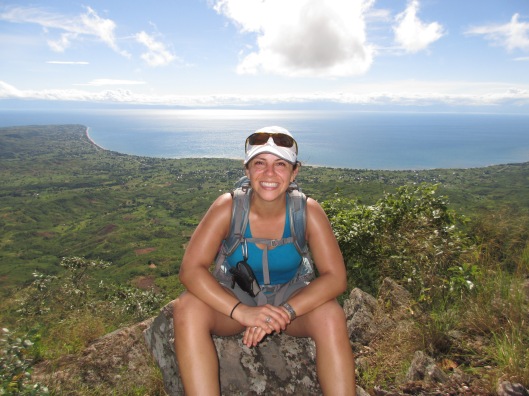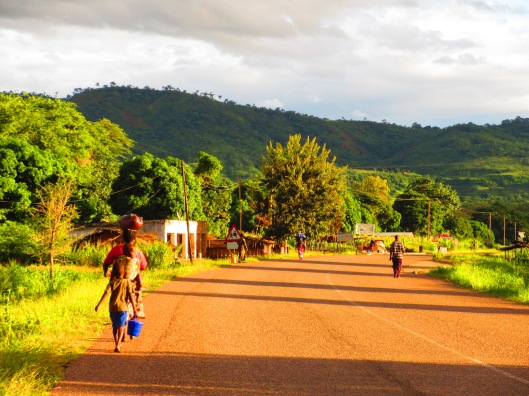After three very early mornings, it was not my natural inclination to embark on a hike the first morning in Malawi at 6am. But after the initial blurry eyed pain of awaking to the dawn, and walking out of the campsite, I was immediately washed over with gratitude for my decision to go. We would be leaving the lakeshore and heading up into the hills to the settlement of Livingstonia – named after David Livingstone by a subsequent doctor and Christian missionary by the name of Robert Laws towards the end of the 19th century. Unlike Tanzania, about 80% of the population is Christian, and it’s hard to believe that this is only the case because of the western missionaries who devoted their entire lives to living through the physical hardships of 19th century Africa to spread the word of Christ. Livingstone, and the explorer Stanley who later journeyed to this continent to find him when he went missing, are very much part of the lore of the places we’ve visited thus far – and if any of you, dear readers, can recommend a book that I might acquire that would give me a good readable account of their lives and work, I’d be most appreciative as I find myself now really wanting to know more about them and the context of what they did.
Livingstonia today is a thriving community of about 4000 inhabitants and it still has the church, and hospital established by Dr Laws as well as two technical colleges for the surrounding villages and towns. The Muzungu, or white person, is not an uncommon sight in this area (still lots of western volunteer health workers and missionaries) and thus the locals that we came into contact with showed no signs of surprise or judgment when we engaged them.
My body was super stiff and sore from the long days of travel and soon I was revitalized by the effort and physical challenge of a steep climb through tropical forest, an ever changing view of the lake below us. Our guide’s name was Dickson, and during the course of what turned into a 13 hour hike, I got to know him quite well. Well, at least as well as his somewhat limited English could communicate.
Dickson was 27 years old and raised his two younger siblings from the age of 12 when both of his parents died from cerebral malaria. He told me that he chose to work to support his brother and sister and help pay for their school fees and that once they graduated, he wanted to go learn how to be a mechanic. It turns out that he was doing a favor for a friend of his who typically guided this tour who found himself hung over this morning after too much beer the night before. As such, Dickson was woefully under prepared for a day of physical exertion in the heat. He had already walked 4kms from his home when he picked us up from our campsite at 6am, and wasn’t carrying any water, food, or money for the day. I got really worried for him, but he continued to refuse any of the water that I had drunk on our ascent which took four hours of climbing along switchbacks in a muggy forest before emerging into the village of Livingstonia, which thankfully had ample tree-lined streets for shade. I had already finished my two litres when we got to the church, and thank goodness I had my Steripen, as we were able to refill all of our bottles at a public tap and treat it there and then (Sandrine and Benoit were the only other two from our group who decided to do this day trip with me) I insisted on sharing snacks with Dickson all day and then bought him lunch from some locals that were having a Sunday picnic outside the church after service.
Hours later, finally having broken down and acquiescing to share my water thirstily for our descent, Dickson admitted that he had been thirsty on the ascent, but that he didn’t want to deprive us of our supplies, and also that he was too poor to buy a bottle that he could re-use for his job as a guide. Getting only ½ of what we paid for the trip, he stood to earn $4.50 for his very long day (I ended up giving him a 5 dollar tip, though I was later plagued with guilt that even this wasn’t enough, and was tortured with the knowledge of what a true impact 20 dollars would have in his life – and very little in mine) If true, this information breaks my heart and I took his address at the end of the day and promised I would mail him some reusable plastic bottles – making him promise me that he wouldn’t lead this trip again without ample hydration.
Apart from enjoying the society of our sweet natured, if inadequately prepared guide, we were lucky enough to interact with a number of locals during our visit of Livingstonia. It was Sunday, so all the villagers were dressed in their Sunday best as they attended church. Though we couldn’t understand the service, the three of us went into mass for a half hour or so, and I thoroughly enjoyed the congregation’s energy and the incredibly harmonious singing was emotive and powerful. Our joy was somewhat muted when the Parish deacon came over to us and insisted we pay him 500 quatcha for the privilege of entering the church. That was a first – being charged money to attend mass??
We got to sit in the grass under the shade of a giant tree and eat a picnic lunch with our hands together with the parishioners who sold us barbecued chicken, sima (a rice like starch made from corn) and beans. A few of the kids played with us and let us take their photographs – their smiles lighting up their faces as they giggled with us.
After lunch, we visited the museum which used to be the residence of the founder of Livingstonia, Dr Robert Laws. It housed some interesting exhibits that detailed what life had been like here in the early days of the Christian ministry – battling malaria, tribal warfare, anti-colonial uprising and the efforts made by those missionaries to inform the world and put an end to the atrocities of the slave trade that was being ran by the Portuguese through Mozambique, supplying Africans to the middle east. Incidentally, almost all of those unfortunate male slaves that were sent to Oman and other areas in that region were castrated before making the voyage – which is why there is only a small remaining population of these Africans’ descendants in the middle east, as opposed to the vast communities that developed in the Americas.
The one story on display that really touched me was when civil anti-colonial unrest broke out in Malawi in 1959, and concerned for the European missionaries lives, the English sent an airplane that dropped a canister containing an offer of a rescue should they be in fear of their lives. They were to construct the letter V if they wanted to be rescued or the letter I if they were ok, the letters needing to be big enough that they would be visible to the plane that would fly overhead the next day. After discussing it, the white missionaries decided they would stay the course, but wanting to convey the message that blacks and whites could co-exist in harmony during those turbulent times, they spelled out a biblical verse above the letter I, finishing it just as the plane showed up. The verse was Ephesians 4:2 and the bricks they used have since been whitewashed and are still preserved for visitors like us to see when they visit.
Since it was getting late in the afternoon, the three of us decided that we should take some form of transport to get back, otherwise we’d be facing a roughly 28 km or 18 mile day and we’d not get back to the campsite before dark. Dickson arranged with a local truck to pick us up outside the waterfall in an hour or so, giving them his cell phone number to call when they were ready to depart. We proceeded to have a leisurely swim at the waterfall named Macheme falls – which were unique in that we swam in a pool that had formed BEFORE the falls plunge some 300 feet, such that it took the appearance of an infinity pool that if you swam too close to the edge, you might get caught up in the flow and fall to your death.
We stayed well away from the edge.
To our dismay, when we walked back to the road to start our descent, thinking the truck would eventually show up and give us our ride, Dickson told us that they had probably called his phone during a 5 minute block of time when his phone didn’t have reception and they had already left without us. It was already 3pm and we were facing a 3 to 4 hour hike down, which ended up taking even longer because Sandrine had a bad knee and had to descend the switchbacks with a great deal of care.
It was a long long day – and we ended up walking into the campsite around 7:30pm, blistered and filthy – but my heart was full of joy. I’d had the kind of day that I’d imagined I’d have when I was planning this trip to Africa – it contained all the elements of travel that I find so richly rewarding – beautiful scenery, physical challenge, meaningful interaction with locals, history of the area, and a moral impression of gratitude for all that I have that will stay with me for a long time to come.
I collapsed in my tent that night, spent, but happy. It had been the best day of the trip thus far.






Anita. I’m so glad to read you had a good day. You were a bit overdue for one 🙂